“It’s quite satisfying when you know you’ve made a difference” - Behind-the-scenes with Halifax staff at the Yorkshire Air Ambulance
and live on Freeview channel 276
It requires stamina, mental toughness, excellent decision-making skills, extensive medical expertise and a calmness under the most intense pressure.
“It’s varied, you don’t know what’s going to happen every day,” says Pete Rhodes, from Sowerby Bridge, who has been a paramedic for 19 years. “It might be you have a quiet day, or it could be that you’re pushed to the limit.
Advertisement
Hide AdAdvertisement
Hide Ad“What I love about this job is that you’re exposed to quite a lot of critical jobs, you get to use a lot more skills, and because you use them frequently, you get better at it.
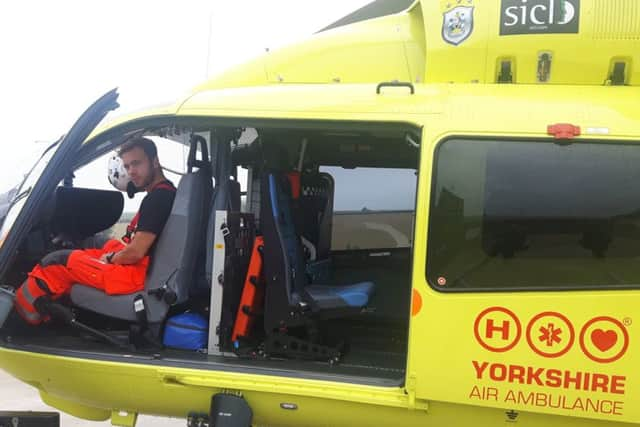

“There’s lots of opportunities for training, so it’s really fulfilling.
“Because you’re called to the worst jobs that are going, it may well be that you’ve never dealt with that before.
“The guys on the scene are you looking at you and saying ‘what do we do now?’ and you’re thinking ‘no idea!’.
Advertisement
Hide AdAdvertisement
Hide Ad“Sometimes it’s just a case of looking confident and going through it methodically, whereas inside you’re pedaling really fast. But it’s a case of keeping that within when everyone thinks you’re in control, keeping control and working through it, thinking ‘OK, this and this has happened, and I need to do this, this and this’.
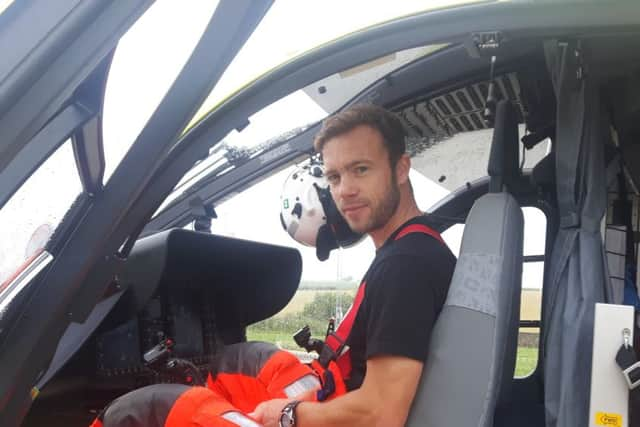

“That’s a big challenge, and when you can do that, it’s quite satisfying at the end of the day, when you know you’ve made a difference.”
“There’s still stuff that shocks me and upsets me,” says Lee Greenwood, from Elland, who has also been a paramedic for 19 years, “especially when it involves children because I’m a dad.
“But I’ve been doing the job for so long that you become hardened to it.
Advertisement
Hide AdAdvertisement
Hide Ad“We actively pick out the worst jobs, that’s part of the job. You’re constantly screening for the jobs where people are hurt or injured, whereas if you work in an ambulance, you don’t know what you’re going to go to.
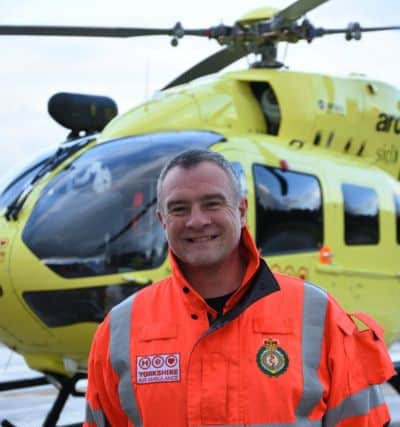

“It’s like actively looking for a gun fight to go into. When we get onto the scene it can be quite chaotic and there can be lots going on.
“Because you turn up in a helicopter there’s an expectation that you’re going to be able to crack on and do what’s best for the patient. But that’s what we’re here for ultimately, and hopefully we get the job done.”
The service operates seven days a week, 365 days a year, attending five incidents a day on average.
Advertisement
Hide AdAdvertisement
Hide AdIn 2018, they attended 1,858 incidents, and carried 416 of those to hospital for emergency treatment.
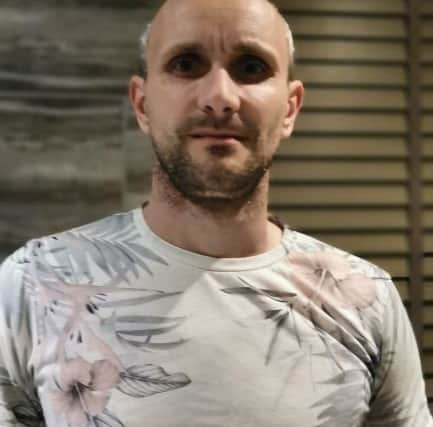

But the service, which is based in Elland and works with medical staff on secondment from the NHS, is entirely reliant on donations, and needs to raise £12,000 every day, the equivalent of £4.4m a year.
It boasts two state-of-the-art helicopters, worth £6m each. One is based at Nostell Air Support Unit near Wakefield, and the other at RAF Topcliffe, near Thirsk.
“I was working with Lee, we’d started at the same time,” recalls Pete of his first call-out with the service. “We were being mentored by Matt, who is now the clinical operations manager, and within a few hours of starting the shift, we found ourselves with a really critically injured patient.
Advertisement
Hide AdAdvertisement
Hide Ad“After showing up in the helicopter, the road crews at the scene had stepped aside and gone ‘this is yours’. I remember I was sorting his airway out while Lee was trying to sort out some catastrophic bleeding, and we both just gave each other a bit of a look of ‘what have we done?’
Unfortunately, there wasn’t a happy ending to the story as the patient died.
“The whole weekend was a baptism of fire to be honest,” reflects Pete. “We realised very early on that that’s the job you’re in now.”
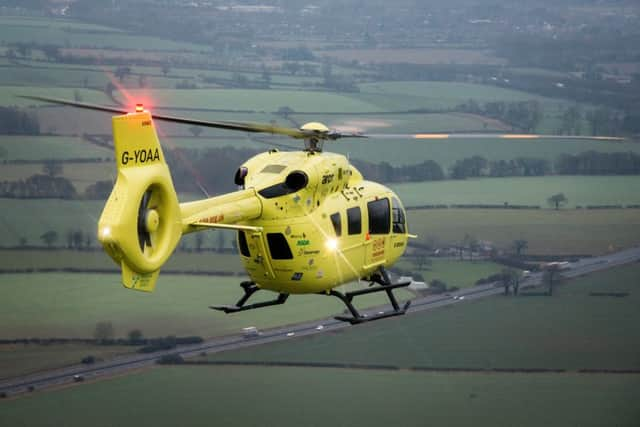

“I went a job in Bradford where a young girl had given birth at a school,” says Lee, citing another example of the demanding nature of the job.
Advertisement
Hide AdAdvertisement
Hide Ad“It happened in the toilets and the teachers had assumed the baby was deceased because it was quite premature.
“When I turned up at the scene with one of my colleagues, we walked through the doors and the other paramedic who was on the scene was pulling the baby out of a bucket, which the teachers had put it in thinking it was dead. But it was still breathing.
“So we resuscitated this baby and took it up to the Bradford Royal Infirmary.
“Then I was on a course about 18 months later, and the teaching staff were using it as an example as to how to do the course really well.
Advertisement
Hide AdAdvertisement
Hide Ad“I said ‘that was me’ and one of the instructors said ‘oh we talk about it all the time!’
“The kid went on to do really well and is absolutely fine.”
Lee says the service has changed a lot since it began in 2000.
“The doctors are now permanent here, and the level of training and skills that the paramedics in the unit have has gone through the roof,” he said.
“We provide a lot more skills and decision-making at the scene now.
Advertisement
Hide AdAdvertisement
Hide Ad“We used to just have road paramedics who gave out morphine, but the role has developed where we can give advanced analgesia, we can do surgical procedures and deliver more advanced decisions on the scene, especially around trauma management.
“It provides a vital and essential function, the ability to get to places quickly and take people to hospital quickly once they’ve had the right treatment is essential.
“Yorkshire’s a big area and the hospitals are quite spread out. And the team here with the enhanced care skills alongside the doctors provide a level of care that you can only get in a hospital emergency department.
“When we arrive, we can bring that level of care to the patient’s side, whether it’s in a field or a side of a road.”
Advertisement
Hide AdAdvertisement
Hide Ad“If you meet somebody or their family, it’s very humbling,” adds Pete.
“There’s the hospital staff, the ambulance staff, it’s not just us who help.
“Because you do it all day, every day, sometimes you don’t realise the affect it has, and occasionally if you meet somebody afterwards and they’ve made a recovery, and you meet their partner or their parents, the gratitude they show you, I certainly think ‘oh, I didn’t realise’.
“At the time, you don’t think about that, you’re just doing your job, and you’re task-focused on what you’re doing.
Advertisement
Hide AdAdvertisement
Hide Ad“It is nice to get that follow up. A couple of years we went to a really poorly little girl near Whitby, and we thought she had meningitis so we took her to James Cook (a hospital in Middlesbrough).
“A few months later I got a letter that she’d written in different coloured pen saying thank you for looking after her.
“That ended up going on my fridge because it was such a lovely thing to happen.
“At the time we weren’t sure if she was going to make it, and then that arrived. All three of us who were on shift got a copy of it.
Advertisement
Hide AdAdvertisement
Hide Ad“I took it home and showed it to my missus, and she burst into tears! So that was nice.
“That was a career highlight really.”
Andrew Woodcock knows only too well how valuable a servce the Yorkshire Air Ambulance provides.
The 42-year-old van driver from Queensbury was involved in a head-on collision with an oncoming vehicle on the A658 Poole Road on 10 September last year.
He sustained multiple fractures to his right foot, a broken and bruised patella and a shattered right femur, undergoing surgery that evening to have a nail inserted and having to stay in hospital for nine days.
Advertisement
Hide AdAdvertisement
Hide Ad“I can remember the fire crew cutting me out and I can remember the helicopter above me but I can’t remember any of the helicopter crew or the journey to the hospital and being treated in the major trauma unit,” Andrew said.
“I never lost consciousness until they started pumping me with drugs, which just sent me into oblivion.
“You see them on TV flying about but you never think that one day you will need them.
“The job they do is fantastic. They must see the best and worst of things. Some of the things they must see must be very difficult to go through.
Advertisement
Hide AdAdvertisement
Hide Ad“I never thought I would need their services, but hopefully it’s just a one in a million.
“It happened on the outskirts of Harrogate, and was about 15 or 20 minutes from the nearest hospital by road, whereas with the air ambulance, you’re talking two or three minutes.
That’s the difference it makes to so many people.
“It could so easily have been a lot worse. They do mean the difference between life and death.”
Abby Barmby, Yorkshire Air Ambulance’s director of marketing and communications, who lives in Halifax, says there is more to the charity than the big yellow helicopters.
Advertisement
Hide AdAdvertisement
Hide Ad“The main charity office has always been based in Calderdale – starting in an office in Dean Clough before we moved to our premises on South Lane in Elland in 2010 where we still reside now,” she said.
“We also have our two airbases where the helicopters operate from at Nostell near Wakefield and RAF Topcliffe near Thirsk.
“The public image of the YAA is very much our pilots, paramedics and doctors who fly in the big yellow helicopters helping to save lives across the region.
“Whilst they are doing a vitally important job, there are other equally important jobs going on behind the scenes to help keep the donations coming in and so the charity runs smoothly to keep the helicopters in the air.
Advertisement
Hide AdAdvertisement
Hide Ad“We have a small team that work from our office in Elland – our admin, finance and marketing teams who all ensure the charity runs as smoothly as possible.
“Then there is also our active fundraising team who work all across the region, liaising and supporting community fundraising events, giving presentations on our work, working with local businesses and generally spreading the word about the vital work we undertake.
“The list is endless really but everyone does their bit to ensure the YAA runs as best it
can.
“No day is ever the same at the YAA, whether you’re operational aircrew, film crew (filming for the popular Really channel series Helicopter ER), or part of the charity team on the ground, but what everyone has in common is their pride and love for being part of such a worthwhile cause.”
To donate to the Yorkshire Air Ambulance, visit https://www.yorkshireairambulance.org.uk/donate/.